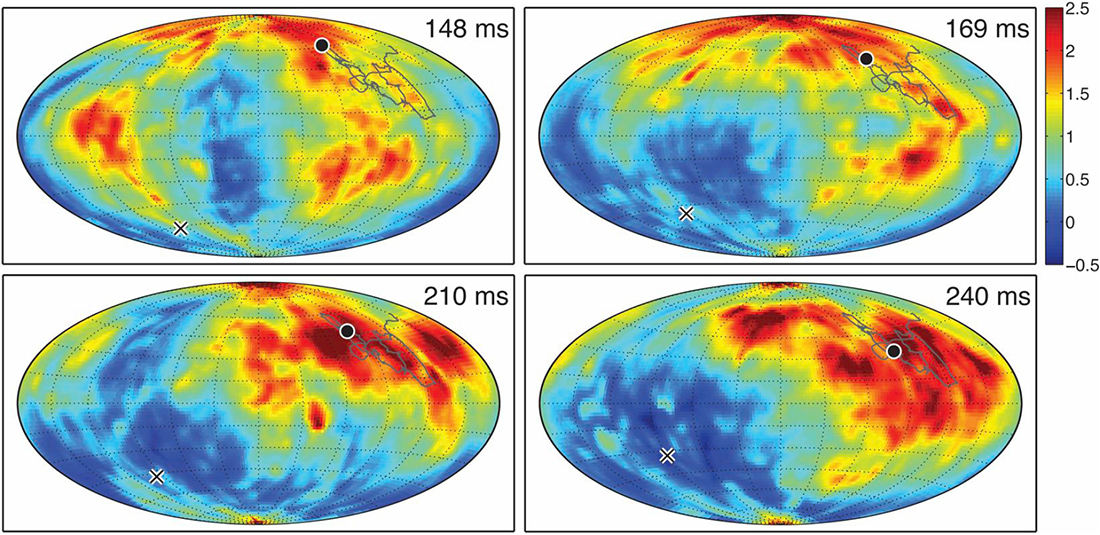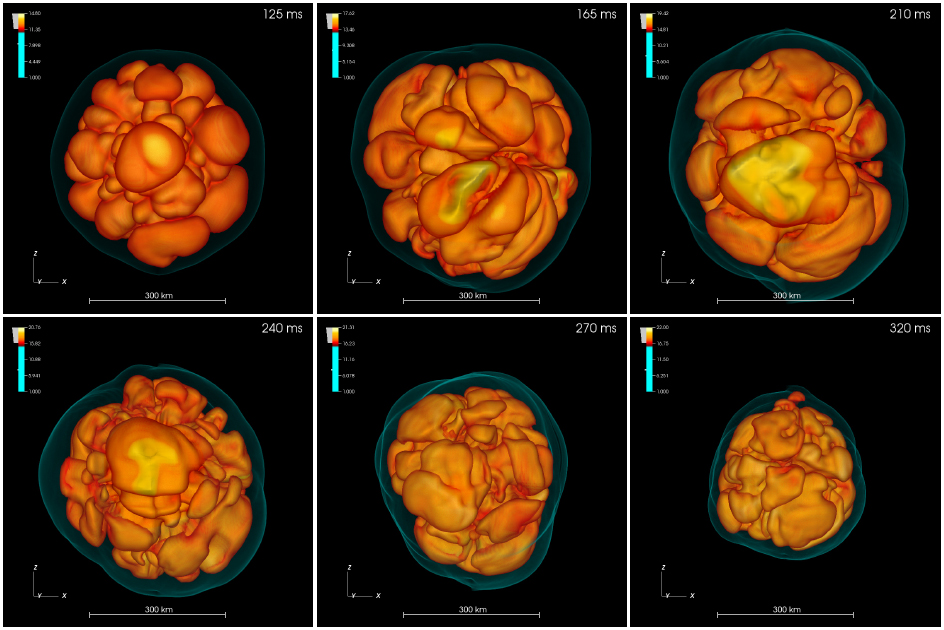ASTROPHYSICS
A New Neutrino-Emission Asymmetry in Forming Neutron Stars
Principal Investigator:
Hans-Thomas Janka
Affiliation:
Max-Planck-Institut für Astrophysik, Garching (Germany)
Local Project ID:
pr86la
HPC Platform used:
SuperMUC of LRZ
Date published:
The Stellar Core-Collapse Group at the Max Planck Institute for Astrophysics (MPA) is able to conduct the presently most advanced 3D supernova simulations thanks to a suitably constructed description of the neutrino physics and a highly efficient, extremely well parallelized numerical implementation on petascale system SuperMUC. Because neither experiments nor direct observations can reveal the processes at the center of exploding stars, highly complex numerical simulations are indispensable to develop a deeper and quantitative understanding of this hypothetical “neutrino-driven explosion mechanism”, whose solid theoretical foundation is still missing.
Neutron stars are born as extremely hot and dense objects at the centers of massive stars exploding as supernovae. They cool by the intense emission of neutrinos, ghostly elementary particles that hardly interact with matter on earth but that are produced in huge numbers at the extreme temperatures and densities in nascent neutron stars. These neutrinos are also thought to trigger the violent disruption of the star in the supernova if only less than one percent of their huge total energy can be tapped to heat the stellar mantle that surrounds the neutron star.
Because neither experiments nor direct observations can reveal the processes at the center of exploding stars, highly complex numerical simulations are indispensable to develop a deeper and quantitative understanding of this hypothetical “neutrino-driven explosion mechanism”, whose solid theoretical foundation is still missing. The computational modeling must be done in three dimensions (3D), simulating the whole star, because turbulent flows as well as large-scale deformation play a crucial role in enhancing the neutrino-matter interactions. This requires the solution not only of the fluid dynamics problem in a strong-gravity environment including a description of the properties of neutron-star matter and of nuclear reactions. In particular the neutrino propagation and processes pose a grand computational challenge, because besides the three spatial dimensions there are additional three dimensions for neutrino energy and direction of motion. Not even the biggest existing supercomputers can solve such a six-dimensional, time-dependent transport problem in full generality.
With a suitably constructed description of the neutrino physics and a highly efficient, extremely well parallelized numerical implementation, the Stellar Core-Collapse Group at the Max Planck Institute for Astrophysics (MPA) is able to conduct the presently most advanced 3D supernova simulations. Nevertheless, despite approximations, one model run, following the supernova evolution for roughly half a second and using 16,000 processor cores in parallel mode on LRZ HPC system SuperMUC, takes about 4.5 months of uninterrupted computing.
On the way of producing the first-ever 3D explosion models with a highly sophisticated treatment of the neutrino physics, the MPA team made a stunning and unexpected discovery: The neutrino emission develops a strong dipolar asymmetry: Neutrinos and their anti-particles are not radiated equally in all directions but with largely different numbers on opposite hemispheres of the neutron star. If this novel neutrino-hydrodynamical instability happens in nature, it is a discovery truly based on the use of modern supercomputing possibilities and not anticipated by previous theoretical considerations. It will lead to a recoil acceleration of the neutron star and will have important consequences for the formation of chemical elements during the supernova explosion.

Figure 1: Evolution of the neutrino emission asymmetry in a collapsing star of 11.2 solar masses. The ellipses represent the whole surface of the nascent neutron star (analog to world maps as planar projections of the Earth's surface). Red and yellow mean a large excess of electron neutrinos compared to electron antineutrinos, normalized to the average, blue means a low excess or even deficit of electron neutrinos. The images show the merging of smaller patches that are present at 0.148 seconds (upper left panel) to a clear hemispheric (dipolar) anisotropy at 0.240 seconds (lower right panel). The dot and cross indicate the emission maximum and minimum, the dark-grey line marks the path described by a slow motion of the dipole direction.
Copyright: Author and The American Astronomical Society
Figure 2: Bubbles of "boiling" gas surrounding the nascent neutron star (invisible at the center). Despite the highly time-variable and dynamical pattern of plumes of hot, rising gas and inflows of cooler matter, the neutrino emission develops a hemispheric asymmetry (see Fig. 1) that remains stable for periods of time much longer than the life time of individual bubbles.
Copyright: Author and The American Astronomical SocietyThis research project was made possible through the Partnership for Advanced Computing in Europe (PRACE) with HPC system SuperMUC of the Leibniz Supercomputing Centre in Garching near Munich and supercomputer CURIE (GENCI@CEA, France) being used as computing platforms.
Publications:
[1] Tamborra I.; Hanke F.; Janka H.-Th.; Müller B.; Raffelt G.G.; Marek, A.
Self-sustained asymmetry of lepton-number emission: A new phenomenon during the supernova shock-accretion phase in three dimensions
Astrophysical Journal 792, 96 (2014), arxiv.org/abs/1402.5418
[2] Tamborra I.; Hanke F.; Müller B.; Janka H.-Th.; Raffelt G.
Neutrino signature of supernova hydrodynamical instabilities in three dimensions
Physical Review Letters 111, 121104 (2013), arxiv.org/abs/1307.7936
[3] Tamborra I.; Raffelt G.; Hanke F.; Janka H.-Th.; Müller B.
Neutrino emission characteristics and detection opportunities based on three-dimensional supernova simulations
Physical Review D 90, 045032 (2014), arxiv.org/abs/1406.0006
Hans-Thomas Janka
Max-Planck-Institut für Astrophysik, Garching
Karl-Schwarzschild-Straße 1
D-85748 Garching/Germany
e-mail: thj@MPA-Garching.MPG.DE